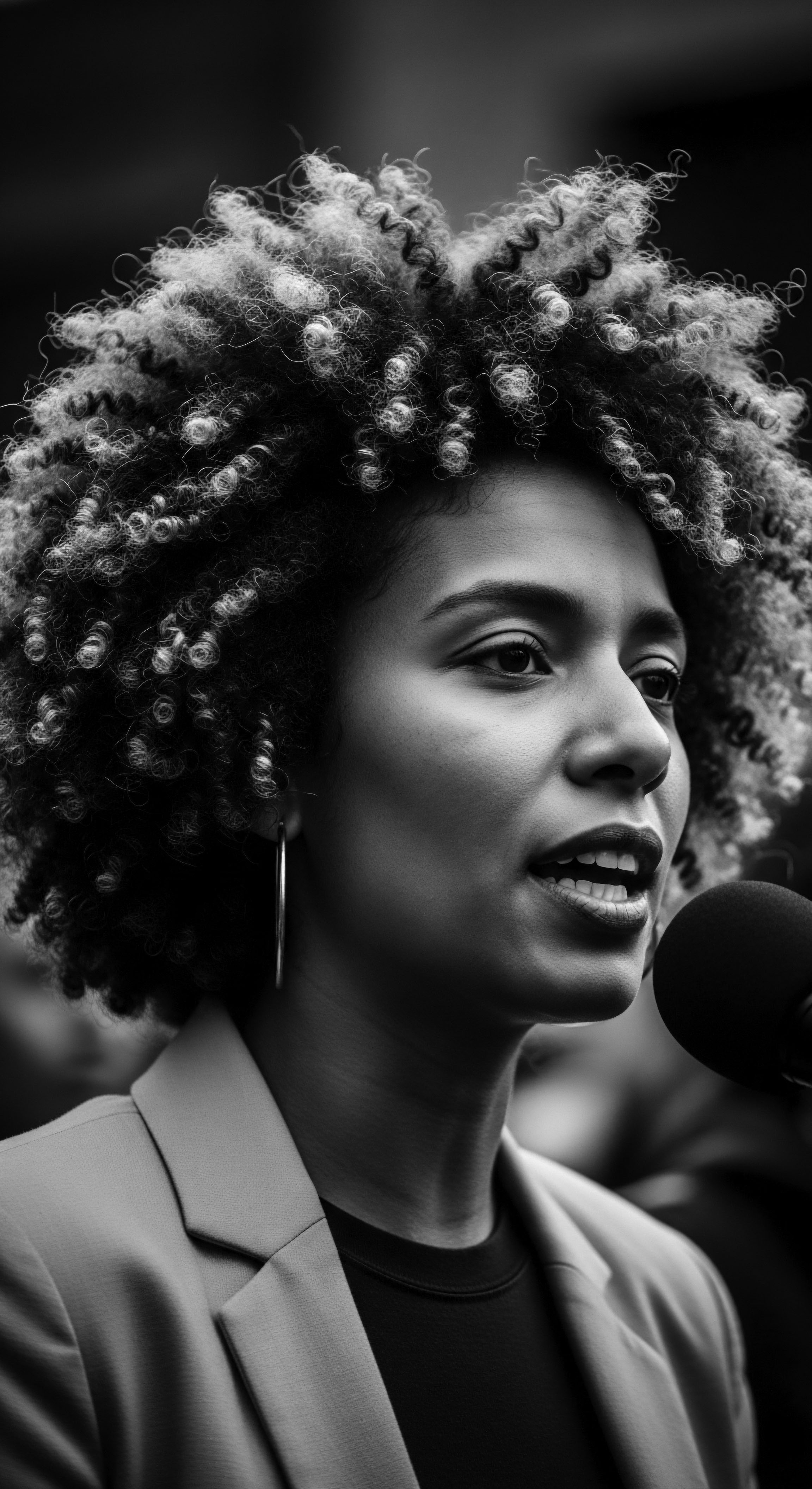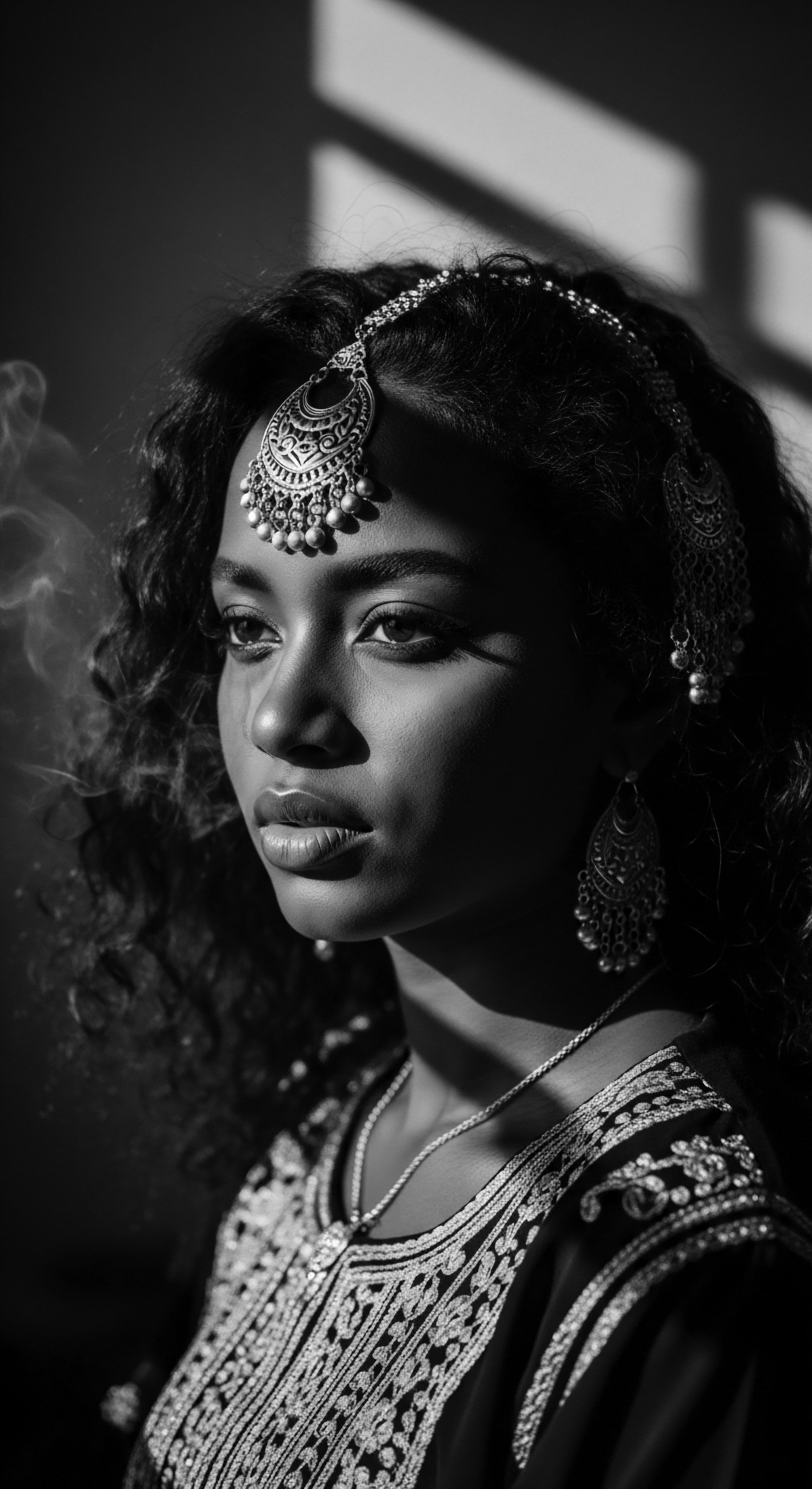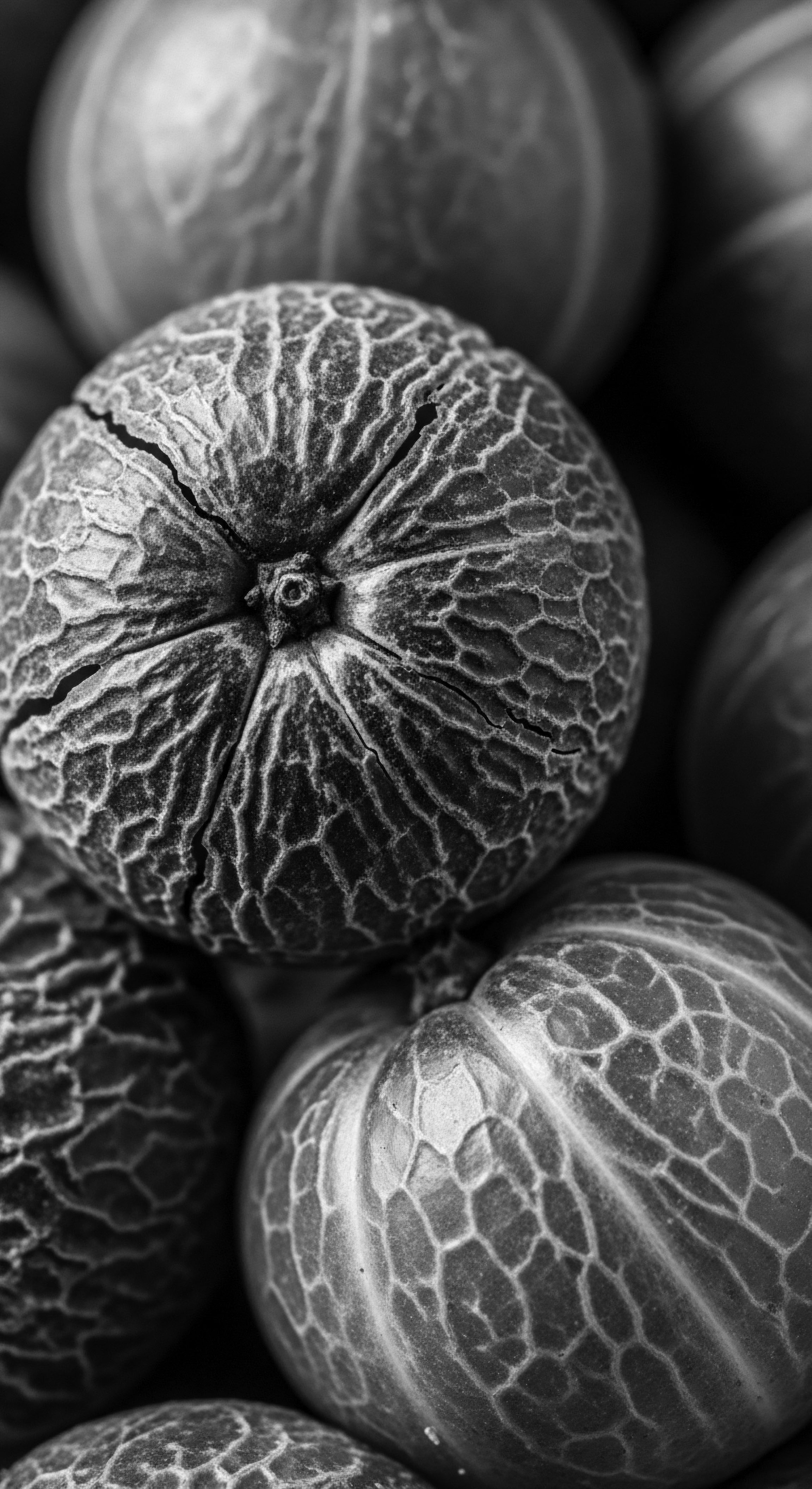
Roots
The very strands that crown our heads hold stories, whispers of generations past, echoing resilience and splendor. For those whose hair coils and twists, whose textures speak of ancient suns and ancestral lands, the connection runs deeper than simple aesthetics. It speaks to identity, to belonging, to an unbroken lineage. Within this profound legacy, the ancient textured hair comb emerges as a quiet but powerful witness, a tool far exceeding its utilitarian purpose.
It acted as a conduit, a physical extension of cultural identity, shaping not only outward appearance but also inner spirit for communities across millennia. To truly grasp this, we must journey back, to where the earliest expressions of self found form in the meticulous tending of hair, recognizing how the hands that held these combs were themselves engaged in acts of heritage preservation.
Consider the earliest forms of textured hair combs, unearthed from archaeological sites in Kush and Kemet, regions today recognized as Sudan and Egypt. Some of these remarkable artifacts date back as far as 7,000 years, with the oldest known comb in institutional collections measuring a striking 6,000 years old. These finds confirm that the ancestry of the Afro comb, with its distinctive vertical design and long teeth, lies firmly within these ancient African civilizations. They were not mere implements; their presence in burial sites alongside their owners suggests a deep personal and perhaps spiritual bond, a recognition of hair’s sacred standing and the tools used in its adornment.
Ancient textured hair combs served as tangible links to cultural identity, shaping ancestral narratives of self-expression and community connection.

Understanding Textured Hair’s Ancient Framework
To appreciate the comb’s significance, one must understand the hair it served. Textured hair, with its unique helical structure, presented distinct care needs and artistic opportunities for ancient communities. Unlike straighter hair types, coily and kinky hair requires specific tools to detangle, section, and style without causing harm.
The design of these early combs, often with wide gaps between their teeth, speaks to an intuitive understanding of this very biology. These ancient artisans and practitioners, without microscopes or modern chemical analysis, understood through generations of lived experience how to work with the hair’s natural inclinations, minimizing breakage and maximizing its inherent beauty.
The choice of materials for these early combs also reflects a deep connection to their environment and available resources. We find combs crafted from:
- Wood ❉ Readily available, often carved with precision and cultural motifs.
- Bone ❉ From various animals, demonstrating resourcefulness and sometimes spiritual connections to the animal itself.
- Ivory ❉ A more precious material, indicating status, wealth, or ceremonial use for certain individuals or groups.
These materials were not chosen at random; they held practical value, symbolic weight, and artistic potential, intertwining the natural world with human expression.

How Did Early Comb Designs Reflect Community Values?
The designs gracing these ancient combs often went far beyond simple decoration; they were coded messages, visual archives of community values, beliefs, and social structures. Symbols engraved upon them could convey tribal identity, social rank, and even spiritual protection. In Kemet, for instance, combs featured depictions of birds, bulls’ horns, and hippopotami, reflecting a reverence for nature and its spiritual forces. These carvings served as constant reminders of a person’s place within their world and their connection to the unseen.
Early designs also hinted at the evolution of hairstyling practices and the types of hair being cared for. The variations in tooth length and spacing suggest adaptations for different textures and styles, from tightly coiled locks to more expansive forms. This adaptability underscores the resourcefulness of ancient communities, tailoring their tools to the biological realities of their hair while simultaneously imbuing them with profound cultural meaning. The comb, then, was not merely a functional artifact; it was a testament to the scientific observation and artistic ingenuity of ancient peoples in preserving and celebrating their heritage through their hair.

Ritual
Beyond the physical form and material composition, ancient textured hair combs became imbued with layers of ritualistic and ceremonial meaning, cementing their role within the cultural identity of communities. Hair care, far from being a solitary act of grooming, transformed into a communal practice, a space for shared stories, generational wisdom, and the reinforcement of social bonds. The comb, held within these intimate moments, became a silent participant in the unfolding of a community’s heritage. It was not just about disentangling strands; it was about connecting with tradition, receiving blessings, and actively participating in the living history of one’s people.
In many ancient African societies, hair carried immense spiritual and social weight. It was seen as the most elevated part of the body, a conduit to the divine, or a vessel for one’s spiritual power. Consequently, the tools used upon it also acquired a sacred aura. Combs, especially those with intricate carvings or made from significant materials, were not casually handled objects.
They were respected, often passed down through families, carrying the accumulated blessings and histories of those who had used them before. This reverence transformed the act of combing into a ritual, a deliberate and mindful engagement with personal and collective heritage.

How Were Combs Used in Traditional Ceremonies?
The application of combs extended to significant life events, marking transitions and celebrating milestones within communities. Consider the Akan people of Ghana, where combs, particularly the wooden Duafe, held deep sentimental value. These were often presented as gifts, from men to women, marking special occasions such as puberty celebrations, weddings, or births.
A comb given in this context was more than a token; it was a physical manifestation of affection, a blessing for femininity, patience, and care. The imagery on these combs often depicted symbols of royalty, love, and wisdom, illustrating the relationship between the giver and receiver, and the values upheld by their society.
Conversely, some cultural nuances showed divergence in meaning; a comb presented by the Yoruba, for example, could signify a desire to end a relationship. This duality underscores the sophisticated semiotics embedded within these seemingly simple objects. The comb acted as a silent language, communicating complex social dynamics and emotional states.
The role of combs in various traditional contexts highlights a deep understanding of human connection and communication:
- Rites of Passage ❉ Combs helped prepare individuals for new life stages, with specific styles or acts of combing signifying maturity or readiness for marriage.
- Social Markers ❉ Hairstyles fashioned with combs communicated social standing, age, marital status, or even clan affiliation without uttering a single word.
- Spiritual Adornment ❉ Some combs or styles created with them were believed to invite spiritual favor or offer protection, particularly when adorned with specific symbols.

What Role Did Combs Have in Ancestral Practices?
The historical record reveals that hair styling in pre-colonial Africa was a time-consuming and often collaborative process, involving washing, oiling, braiding, twisting, and decorating. This communal activity, centered around the manipulation of hair with tools such as combs, created opportunities for bonding, storytelling, and the transmission of ancestral knowledge. The hands that combed hair were also the hands that passed down wisdom, myths, and the collective memory of a people.
An archaeological study of early medieval Britain, while not focused on textured hair specifically, points to the profound personal significance of combs in funerary practices. Combs were frequently discovered in cremation burials, often placed with the deceased as part of post-cremation rites. This practice suggests combs were considered significant items for maintaining the body’s appearance in life, serving to reconstitute the deceased’s personhood in death.
While different in cultural context, this echoes the profound reverence for personal grooming tools found in ancient African burials, where combs were interred as symbols of status and personal worth. This parallel suggests a fundamental human connection to personal items, particularly those associated with identity and self-presentation, across diverse cultures.
| Culture Akan (Ghana) |
| Symbolic Meaning of Comb Femininity, beauty, patience, love, wisdom, prosperity; given as gifts to mark significant life events. |
| Culture Yoruba (Nigeria) |
| Symbolic Meaning of Comb Potential end of friendship or relationship (if given as a parting gesture). |
| Culture Kemet (Ancient Egypt/Sudan) |
| Symbolic Meaning of Comb Status, luxury, connection to nature and deities, spiritual power, ritual significance. |
| Culture Ancient combs functioned not just as grooming tools but as vessels for complex cultural, social, and spiritual expressions. |
The legacy of these rituals persisted even through times of immense upheaval. During the transatlantic slave trade, when enslaved Africans were often shorn of their hair as a tactic to strip them of identity and culture, the knowledge of textured hair care and the significance of combs did not vanish. It adapted, becoming a quiet act of resistance, a means of holding onto humanity and heritage in the face of forced erasure. Makeshift combs from wood, metal scraps, or even animal bones were fashioned, allowing essential practices to endure and for a deep connection to ancestral ways to persist.

Relay
The enduring legacy of ancient textured hair combs extends beyond the realm of ritual and personal adornment, reaching into the very core of cultural survival and resistance. These objects, simple in their form but immense in their meaning, served as powerful conduits for the transmission of heritage across generations, particularly within Black and mixed-race communities. The way they were made, used, and understood represents a living archive, demonstrating how tools of personal care could become symbols of collective identity and profound social statements. This historical continuum speaks volumes about the human spirit’s capacity to preserve cultural memory, even when faced with concerted efforts to dismantle it.
The scientific understanding of hair’s anatomy, particularly textured hair, aligns seamlessly with the intuitive wisdom of ancestral practices involving these combs. The distinct helical structure of coily and kinky hair makes it prone to tangling and breakage if handled improperly. The wide-toothed designs prevalent in ancient African combs were not accidental; they were a practical solution to preserve the integrity of these delicate strands.
This historical ingenuity, born from necessity and observation, finds validation in modern trichology, which advocates for tools that minimize friction and stress on the hair shaft. This confluence of ancient wisdom and contemporary science underscores the authority and efficacy of these traditional practices.
The story of ancient combs is one of ingenious adaptation, scientific understanding, and profound cultural survival.

How Did Ancient Comb Design Anticipate Modern Hair Science?
The fundamental principles embedded in the design of ancient textured hair combs, particularly their wide spacing, reflect an innate understanding of hair physiology that predates formal scientific inquiry. Ancient communities recognized the need to move through densely packed, coiling hair without disturbing its natural pattern or causing mechanical damage. This led to combs with fewer, broader teeth, a stark contrast to the finer-toothed combs more suitable for straight hair. This design minimizes breakage points along the hair shaft and respects the curl’s integrity.
This traditional approach aligns with contemporary understanding of textured hair’s unique characteristics. Modern scientific studies confirm that excessively fine-toothed combs can lead to cuticle damage, knotting, and hair loss in coily hair types. The ancestral wide-toothed comb, by virtue of its very structure, mitigates these issues.
It allows for gentle detangling, moving through the hair with minimal resistance. This empirical wisdom, gathered over centuries of practice, speaks to a sophisticated, albeit unwritten, scientific understanding passed down through generations.
For instance, the ancient Egyptian combs unearthed from Kush and Kemet, dating back 6,000 to 7,000 years, often featured these characteristic long, widely spaced teeth. This design permitted effective care for diverse hair types within the population, including the varied textures found in ancient Egypt and Nubia.
A powerful historical example of the comb’s connection to cultural identity through adversity is its role during the period of enslavement and its resurgence in the 20th century. During the transatlantic slave trade, the forced shaving of hair was a deliberate attempt to strip Africans of their cultural markers and identity. Deprived of traditional tools and ingredients, enslaved people devised ingenious methods of hair care, using what was available. However, the knowledge of the importance of hair and the cultural practices surrounding it persisted, often passed down through clandestine means.

What Enduring Ancestral Wisdom Do Combs Carry?
The late 20th century saw the Afro comb, a direct descendant of these ancient tools, become a potent symbol of empowerment and resistance within the Black Power movement. The iconic comb, often topped with a clenched fist, represented a bold rejection of Eurocentric beauty standards and a defiant embrace of natural hair textures. Wearing an Afro, styled with such a comb, was a public declaration of racial pride and a visible assertion of collective identity. This was not merely a trend; it was a reclaiming of a deeply rooted heritage, a direct echo of ancestors who used combs to express status, spirituality, and community belonging.
The journey of the comb, from ancient ritual object to a symbol of 20th-century political liberation, powerfully demonstrates its enduring significance. The parallels between ancient African combs and the 1960s Afro picks, particularly in their structural design and symbolic weight, are indeed uncanny. This continuum reveals a persistent thread of cultural self-determination woven through millennia. The materials changed, from ivory and bone to plastic, but the purpose remained constant ❉ to honor textured hair, uphold cultural identity, and express resistance against oppressive norms.
The communal aspects of hair care, often facilitated by the comb, also survived the transatlantic crossing and continued in new contexts. The hours spent styling hair in pre-colonial Africa were opportunities for social bonding and the transmission of oral histories. Even in the face of immense hardship, these practices, often involving the use of repurposed tools, became quiet spaces for maintaining familial and community ties, reinforcing shared heritage and resilience. The comb, therefore, acted as a silent guardian of these traditions, facilitating both the physical care of hair and the preservation of cultural memory.

Reflection
To hold an ancient textured hair comb, or even its contemporary iteration, is to hold a fragment of profound human history. It is to feel the echoes of hands long past, meticulously shaping crowns of coiled strands, not just for adornment, but for identity, for spirit, for a vibrant heritage. Roothea’s ‘Soul of a Strand’ ethos reminds us that hair is never simply a biological outgrowth; it is a living archive, each helix carrying tales of resilience, beauty, and ancestral wisdom. The journey of these combs, from the dawn of civilization in Kemet to the defiant assertions of the Black Power movement, speaks to an unbroken, living tradition.
The meticulous craftsmanship of early combs, carved from bone and wood, speaks to a deep, inherent knowledge of textured hair’s unique needs. This early understanding, unwritten yet deeply rooted in practice, mirrors the scientific insights we now validate through modern trichology. It is a compelling testament to the ingenuity of our ancestors, whose care rituals were not merely aesthetic but biologically attuned and culturally profound. The comb, therefore, stands as a symbol of human adaptability, transforming raw materials into tools that both served a practical purpose and communicated complex social, spiritual, and political messages.
As we reflect on these ancient connections, we recognize that the cultural identity bound to textured hair combs is not a static relic of the past. It is a dynamic force, a continuous thread connecting generations, shaping perceptions, and inspiring ongoing expressions of self and community. The presence of these combs in burial sites, laden with symbolic meaning, highlights a timeless reverence for personal items that define who we are in life and beyond. The comb remains a touchstone, urging us to honor the wisdom of those who came before us, to understand the deeper meanings woven into our daily rituals, and to celebrate the enduring legacy of textured hair as a powerful emblem of identity and heritage.

References
- Ashton, Sally-Ann. “6000 years of the culture, politics and identity of the Afro Comb explored.” LSE Research Online, October 21, 2013.
- Heywood, Felicity. “Afro comb ❉ the cultural and political legacy behind this iconic hair tool.” CurlyTreats, February 8, 2025.
- Byrd, Ayana, and Lori L. Tharps. Hair Story ❉ Untangling the Roots of Black Hair in America. St. Martin’s Press, 2001. (Referenced through snippets)
- Williams, Howard. “Material culture as memory ❉ combs and cremation in early medieval Britain.” Early Medieval Europe 12, no. 2 (2003) ❉ 101-128.
- Ashton, Sally-Ann. “Combs from Kemet ❉ further thoughts on ancient Egyptian hair combs.” Kemet Expert, February 25, 2016.
- “Strands of Inspiration ❉ Exploring Black Identities through Hair.” Smithsonian National Museum of African American History and Culture, August 16, 2023.
- “The African Tales of The Historical 7000 Year Old Afro Comb.” Africa Rebirth, April 18, 2022.
- “Evolution of Style ❉ Tracing the History of Hair Combs.” Margaux Salon, October 27, 2023.
- “The History and Evolution of the Hair Comb ❉ From Ancient Times to Today.” TikTokgoodshop, September 8, 2024.
- “A Sacred Legacy ❉ On Black Hair And The Revolutionary Power of Self-Exp.” GirlsOnTops, August 31, 2020.
- “African Hairstyles – The “Dreaded” Colonial Legacy.” The Gale Review, November 23, 2021.
- “Project background – Origins of the Afro comb.” University of Cambridge, Accessed June 16, 2025.
- “Origins of the Afro Comb ❉ 6000 years of culture, politics and identity, the Fitzwilliam Museum.” Fitzwilliam Museum, October 27, 2013.
